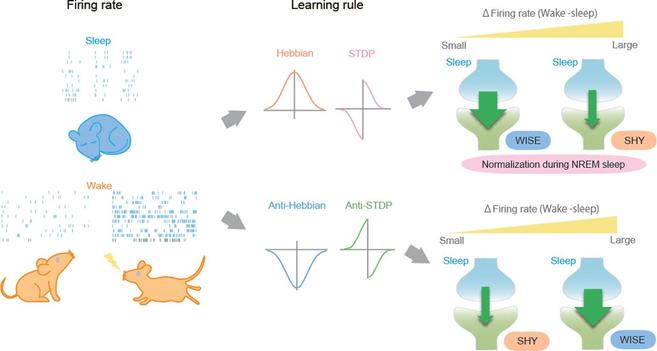Conflicting results have been obtained re changes in synaptic strength in the #CerebralCortex during the #Sleep-WakeCycle. This computational study provides a comprehensive understanding & unified framework about #synaptic dynamics during #sleep & wake states @PLOSBiology https://plos.io/4kHeNwM
#CerebralCortex
Giant Fusiform Cells of the Brain: Discovery, Identification, and Probable Functions - #giantfusiformcellsofthebrain #cerebralcortex #cytoarchitectonics #comparativebiology #historyofneuroscience #VolodymyrBetz #SantiagoRamonyCajal #ConstantinvonEconomo - https://link.springer.com/article/10.3103/S0095452724050098
🚨 NEW PAPER OUT IN #cerebralcortex🚨
#hurst exponent of fMRI data from the developing #humanconnectomeproject
👶
Surprisingly, at preterm age, signals were anti-correlated (H < 0.5) but later became long-term positively autocorrelated (H > 0.5) at term; like we see in adults
https://doi.org/10.1093/cercor/bhae426
🧵
L'amore è anche una questione di cervello. Scoperta nel cervello la ‘casa dell’amore’. Studio finlandese svela dove risiedono i sentimenti per figli, partner e animali. Un team di scienziati dell'università di Aalto ha indagato sei tipi di amore, ognuno dei quali illumina parti diverse del nostro cervello. Quello genitoriale sembra avere una marcia in più.
L'amore? Una questione di cervello.
#CerebralCortex #cervelloumano #meccanismineurali #neuroscienze #tipidiamore
https://scienzamagia.eu/sociale-collettivita/lamore-e-anche-una-questione-di-cervello/
🐦 Exciting News! 🐦
New research from Durham University shows how both sighted and blind people can train their brains to echolocate using sound echoes, just like bats and dolphins! 🦇🐬
Over 10 weeks, 12 blind and 14 sighted participants learned echolocation through click-based training. The results? MRI scans revealed that their brains adapted in similar ways, reorganizing the primary visual cortex to process sound echoes! 🧠🔍
This groundbreaking study proves that our brains are incredibly adaptable, no matter our sensory abilities. 🌟 This offers new hope for those with progressive vision loss, demonstrating that with practice, we can develop new ways to navigate our surroundings. 🌍✨
Kudos to the amazing researchers, Dr. Lore Thaler and Dr. Liam Norman, for leading this innovative study. Your work is truly inspiring! 👏👏
Read more about this incredible study in the journal Cerebral Cortex. 📚
#Neuroscience #BrainPlasticity #Echolocation #Blind #VisionLoss #Research #Innovation #DurhamUniversity #CerebralCortex #Inspiration #ScienceNews #HopeForTheFuture 🌟🔬🦸♂️🦸♀️
#WarrenBrown - What Is #Consciousness?
https://www.youtube.com/watch?v=THaRnugEU3s
#Philosophy #PhilosophyOfScience #Science #PhilosophyOfConsciousness #SelfConsciousness #PhilosophyOfMind #Mind #Emergence #Brain #Cortex #CerebralCortex #Memory #Neuroscience #Neurophysiology #Action #IntentionalStates #Intentionality #NervousSystem #Phenomenology #Qualia #Experience #CloserToTruth #RobertKuhn
@lzg my grandma suffered several strokes.
We took care of her, she lost the ability to speak for 3 or 4 months.
After a great therapist helped her, she regained speech via repeating ONE WORD that we understood thanks to tone and frequency variations.
#CerebralCortex #FrontLobe #Speech #Therapy #Neurons #BrainRecovery
“Cortical circuitry mediating inter-areal touch signal amplification” by Ryan et al. 2023 (Simon Peron lab). https://www.biorxiv.org/content/10.1101/2023.06.06.543886v1
“we ask how topographically matched subregions of primary and secondary vibrissal somatosensory cortices (vS1 and vS2) interact during whisker touch.”
And found cortical layer 2 neurons responsible for interarea synchrony.
“we identified a sparse subset of neurons in the primary visual cortex (V1) and higher visual areas that respond emergently to ICs [illusory contours]. We found that these highly selective "IC-encoders" mediate the neural representation of IC inference. Strikingly, selective activation of these neurons using two-photon holographic optogenetics was sufficient to recreate IC representation in the rest of the V1 network, in the absence of any visual stimulus.”
From: “Recurrent pattern completion drives the neocortical representation of sensory inference” by Shin et al. 2023 https://www.biorxiv.org/content/10.1101/2023.06.05.543698v1
Switchable neural components in turtles. Perhaps not surprising but certainly extraordinary! The source paper:
"Responses of the in vitro turtle brain to visual and auditory stimuli during severe hypoxia", Ariel et al. 2023 https://doi.org/10.1242/jeb.244687
"North American pond turtles (Emydidae) are renowned for their ability to survive extreme hypoxia and anoxia, which enables several species to overwinter in ice-locked, anoxic freshwater ponds and bogs for months."
These qualities make turtles fantastic laboratory animals for neuroscience research:
"Large-scale mapping of cortical synaptic projections with extracellular electrode arrays", Shein-Idelson et al. 2017 https://www.nature.com/articles/nmeth.4393
#neuroscience #reptiles #Testudines #turtles #vision #CerebralCortex #hibernation
@Javierzsm A great reminder that the activity of a neuron matters in a different way to each target neuron type because the postsynaptic site is cell-type specific. Thanks for your work!
https://www.jneurosci.org/content/early/2022/11/09/JNEUROSCI.1661-21.2022
